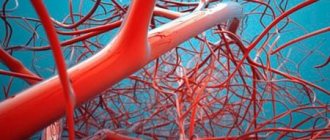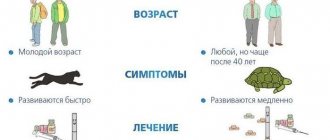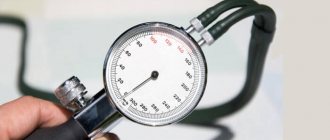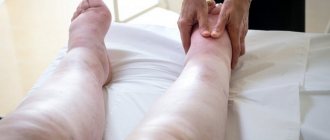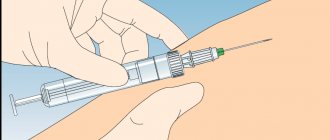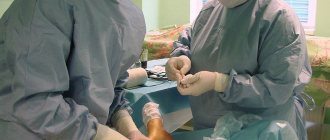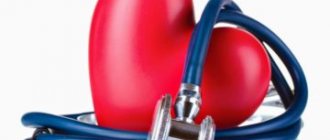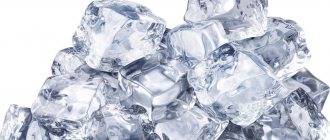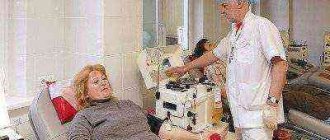Varicose eczema, as a rule, is a concomitant pathology of diseases such as varicose veins and thrombophlebitis. The inflammatory process on the skin usually begins unnoticed and does not cause serious discomfort. With late detection and treatment of the pathology, a complicated form of dermatosis develops with the appearance of ulcers.
Disease code according to the ICD-10 system: L30 Eczema and dermatitis.
Causes
Eczema of the varicose type mainly occurs in old age; children and adolescents suffer from it much less often. The main cause of the disease is impaired blood circulation and disruptions in the valve system of blood vessels, altered due to an existing disease or pathological condition.
Let's consider what factors can provoke varicose eczema:
- lower limb injuries;
- excess weight;
- pregnancy and childbirth;
- advanced stage of other skin diseases;
- varicose veins;
- thrombophlebitis;
- atherosclerosis;
- diabetes;
- history of surgical interventions on veins;
- heavy physical work or stress;
- intolerance to individual components of cosmetic products;
- increased humidity, excessive hydration of the skin;
- frequent infections and respiratory diseases;
- chronic pathologies of the heart and blood vessels;
- sedentary lifestyle;
- poor nutrition;
- wearing uncomfortable clothes and shoes;
- stress, psycho-emotional stress.
Against the background of these factors, the valves begin to not work at full strength, and therefore the vessels do not compress enough. Blood stagnates in the veins, they swell, which leads to increased pressure in the vessels and disruption of the trophism of the epidermis.
Online test for the presence of the disease
Venous eczema most often affects older people, but the disease can occur in young people and children.
The main cause of the pathology is impaired blood flow and malfunction of the valves. When lymph enters the lower extremities, the blood vessels are blocked for some time and the speed of blood flow is disrupted. As a result, nodes are formed and the walls of blood vessels are deformed. The main causes of stasis dermatitis are:
- leg injury below the knee;
- obesity;
- pregnancy (the more pregnancies and births there were, the higher the likelihood of stagnant dermatitis);
- tendency to allergies;
- advanced stage of other forms of dermatitis, as a result of which varicose veins are added;
- thrombophlebitis;
- vein surgery;
- genetic predisposition;
- heavy physical activity;
- increased sensitivity to components of cosmetics;
- excessive skin hydration;
- wearing uncomfortable shoes with a preference for high heels;
- frequent infection of the body;
- heart and vascular diseases, weakening of valves;
- poor nutrition;
- sedentary lifestyle, sitting for most of the day.
As a result of improper operation, the blood vessels and valves do not compress enough to ensure the transport of fluid from the lower extremities, the veins become clogged, swell, and the pressure in the vessels increases.
If a person has varicose veins, stasis dermatitis can be provoked by:
- stress;
- serious experiences;
- decreased immunity;
- viral infection;
- fungus;
- allergies to care products, clothing material, direct sunlight.
Venous eczema on the legs begins to develop if a person has predisposing factors:
- Features of the structure and condition of blood vessels. Patients experience a decrease in the tone and elasticity of the veins, and their heart valves do not work effectively. The areas of blood vessels in which blood accumulates expand, stagnation develops, and cellular metabolism is disrupted.
- Increased blood clotting. This process often leads to the development of thrombophlebitis and thrombosis.
- Increased load on the lower limbs due to heavy physical work and excess weight.
- The presence of heart disease, pathologies of the endocrine system, skin diseases of an inflammatory or atrophic nature in advanced stages, a tendency to allergic manifestations.
- Hereditary features of the structure of veins are insufficient elasticity of the vascular walls, which is acquired due to deficient collagen production.
- Pregnancy with complications or multiple pregnancy.
According to doctors' observations, the disease begins to develop in patients with reduced immune defense, increased nervous stress and stress. Failure to maintain personal hygiene and insufficient care of the skin of the feet increase the likelihood of a problem.
Venous eczema occurs in 4 stages, each of which has pronounced symptoms:
- It is characterized by the appearance of redness on the skin of the limb.
- It is accompanied by a change in skin color in the affected areas to a red or purple hue, the appearance of swelling, blisters, and small cracks.
- The transition to stage 3 can be determined by the release of liquid from the vesicles, the skin surface is wet to the touch.
- Increased dryness in the problem area, the formation of brown crusts. During this period, the likelihood of developing a purulent process and the formation of trophic ulcers increases.
Symptoms
In most patients, the pathological process begins in the lower leg area, then spreads to other parts of the leg. The main feature of the development of venous eczema is the presence of signs of varicose veins in the patient. In the affected area there is persistent itching, pain, heaviness, and the skin begins to peel off. Symptoms indicate the disease:
- visible changes in the integument, the intensity of the manifestations depends on the stage of the pathology (slight redness, the appearance of red or bluish spots, darkening, formation of compactions);
- severe swelling of tissues, swelling of the legs;
- changes in the structure of the skin, which becomes thin and prone to ulcers;
- the appearance of numerous ulcerative plaques, open wounds, the addition of inflammatory processes;
- severe itching of damaged tissues, their soreness.
What varicose eczema of the lower extremities looks like can be seen in the photo below.
Therapy
Treatment of varicose eczema is aimed at achieving the following goals:
- normalization of blood circulation;
- restoration of healthy skin structure;
- prevention of the development of infectious processes;
- improvement of blood microcirculation in the affected area.
Based on the individual characteristics and condition of the patient, the degree of development of the process, the presence of contraindications, the doctor prescribes several types of treatment - medication, using local remedies, physiotherapy.
To eliminate the symptoms of the disease, it is allowed to use traditional medicine recipes. In severe cases, surgical procedures are indicated.
Local impact
There are several types of topical medications that can effectively combat the manifestations of skin pathology. There are several types of ointments for varicose eczema on the legs.
- Hormonal - Akriderm, Hydrocortisone, Elokom. They contain corticosteroids. They are effective for relieving inflammatory processes, pain, and are indispensable in the fight against edema. The use of hormonal agents provides noticeable results in a short time. They should be used in short courses, as there is a high probability of addiction and the development of adverse reactions.
- Non-hormonal - Ginkor gel, Venoruton. They are prescribed to improve skin condition and tissue regeneration. They have anti-inflammatory, wound-healing, antibacterial properties. Ointments are used to relieve pain, dry or moisturize damaged skin.
- To combat the signs of varicose veins - Lyoton, Venitan, Heparin ointment. The purpose of their appointment is to improve the condition of the walls of blood vessels, the performance of venous valves, and reduce the risk of blood clots. An additional effect is the elimination of pain and swelling.
For venous eczema of the legs, treatment with medications requires an integrated approach. Appointed:
- Diuretics. They help remove excess fluid from the body and relieve swelling (Furosemide, Lasix).
- Phlebotonics. They are the “main weapon” in the fight against manifestations of varicose veins and venous insufficiency (Detralex, Phlebodia 600, Vasoket).
- Antibiotics. Indicated in the presence of purulent skin lesions (Doxycycline, Baziron).
- Antihistamines. Used for severe itching and inflammation (Fexadine, Loratadine, Cetirizine).
Surgery, as a method of treating venous eczema, is justified in cases where the patient has developed necrotic tissue changes, and blood circulation is severely impaired due to dilated vessels.
ethnoscience
Traditional medicine provides a good healing effect.
- For the base of compresses, you can use grated raw potatoes, a paste of dried wormwood leaves and milk, cabbage leaves, and birch tar. The selected component is laid out on sterile gauze and secured to the problem area with a bandage. After 2-3 hours, the compress is removed.
- Treatment with birch tar helps restore blood circulation in tissues and relieves inflammation. It is applied to exposed areas of the affected skin, covered with a sterile bandage for 1-2 hours daily.
- Foot baths based on chamomile, oak bark, and birch buds will be useful. A decoction for water procedures is prepared based on the proportion - 20 g of raw materials per 1 liter of boiling water. The product must be brought to a boil over heat and simmer for 3-5 minutes. Second preparation option: pour boiling water over the raw material and leave for an hour. Baths are taken for 15-20 minutes every day. The broth should be warm - 35-40 °C.
Physiotherapy
In the treatment of varicose dermatosis, several methods of physiotherapy are used. They are carried out in combination with other therapeutic techniques. Recommended for varicose eczema:
- laser therapy;
- electrophoresis;
- ozone therapy;
- darsonvalization;
- radio frequency radiation;
- exposure to ultraviolet radiation;
- balneotherapy;
- phototherapy.
Prevention
To avoid the development of venous eczema, a patient with prerequisites needs to change their lifestyle and always follow the rules:
- monitor your health, if alarming symptoms appear, contact medical institutions for consultation;
- give up alcohol and smoking;
- be physically active, do not overuse exercise;
- carry out hygiene procedures daily, moisturize the skin with special products;
- prevent disruptions in the body’s immune defenses;
- alternate time between vigorous activity and proper rest.
You need to review your wardrobe, remove uncomfortable shoes, clothes that interfere with normal blood circulation, and items made of wool and synthetic fabrics.
In order to treat and prevent pathology, the doctor recommends that the patient review his diet, exclude or minimize the consumption of a number of foods - milk, eggs, pork and poultry, seafood, legumes, tomatoes, mushrooms. You should pay attention to the method of cooking: fried, smoked, and canned foods are not recommended. Fermented milk products and vegetables should become the basis for creating a “healthy” menu.
If the disease is a consequence of excess weight, you need to reconsider the calorie content of the daily menu. The optimal daily calorie intake is 2500 kcal for men and 2200 kcal for women. The amount may vary depending on the level of physical activity and the usefulness of metabolic functions in the body.
As a result of varicose veins, they swell and protrude above the surface of the skin. Due to the leakage of the liquid fraction of blood through the walls of such vessels, constant local edema occurs, leading to the breakdown of hemoglobin in the tissues, and then to the appearance of weeping areas.
The tissues begin to experience oxygen starvation, which causes changes in the structure of the skin: it becomes more vulnerable, more easily damaged, but the recovery processes are very slow. As a result, fungal (mycoses) and purulent (pyoderma) lesions appear on the epithelium.
Manifestation of varicose dermatitis on the legs
Symptoms
Varicose or venous eczema affects the calves and ankle area, and less commonly the skin of the hands. In the zone of the inflammatory process, the epidermis becomes thinner, microcracks appear on its surface, which can become entrance gates for pathogenic microflora - bacterial or fungal.
There are four stages of varicose eczema:
- The skin on the legs begins to itch and peel. At this stage, the disease can still be prevented if you seek medical help.
- There is swelling and increased dryness of the dermis, and aching pain appears in the affected area.
- In areas of inflammation, eruptive elements containing exudate appear. After 5–7 days they open, forming a wet surface. At this stage, infection easily occurs. The inflammatory process requires complex systemic treatment.
- The stage of subsidence or decline of the pathology. Its main symptom is the formation of yellow crusts. If left untreated, the disease may return to the initial stage of inflammation.
Poor circulation in weakened vessels leads to stagnation of blood in the lower extremities, which is accompanied by swelling of the legs and hematomas. As a result of trophic disturbances, the skin becomes thin and dry to the touch, constant itching appears, which, in turn, provokes redness and detachment of the epidermis, and the appearance of long-healing scratches. The latter can become a gateway for bacterial or fungal infections.
The advanced form of varicose eczema is characterized by an increase in temperature of both the affected area of the limb and the whole body. On skin damaged by dermatosis, bluish or brown spots appear and intense aching pain occurs. Foci of eczema are covered with ulcers and cracks and are widespread. It is not possible to accurately determine the primary affected area.
Types of dermatitis on the legs
They are divided based on certain characteristics:
- Symptoms: dry, weeping, purulent, itchy.
- Form of occurrence: acute (papules and vesicles appear), subacute (crusts and scales form in place of papules and vesicles), chronic (symptoms either decrease or intensify).
- Acute stage of the disease: erythematous (erythema with swelling), vesicular (bubbles burst, weeping dermatitis occurs, periodically dries out with the formation of crusts), necrotic (tissues die in place of crusts, the skin becomes rough, scars form).
Any type of eczema is unattractive and causes a lot of inconvenience.
Venous or varicose
Caused by diseases of the venous and vascular system. Usually patients do not pay due attention to these problems. As a result, they do not receive the necessary treatment.
Blood circulation in the lower extremities is impaired. Blood stagnates in the vessels. Eruptions appear on the skin. Especially over veins that have ceased to perform their functions. Dermatitis is classified as stagnant. It takes a chronic form.
Affects the ankles and legs. Mostly women over 50 years of age are affected. They have a history of varicose veins, heart disease, thrombophlebitis.
Inflamed lesions peel, swell, and itch. The pain turns into a burning sensation.
In the absence of adequate treatment, venous dermatitis can develop into ulcerative dermatitis.
Contact
This type is considered uncomplicated and occurs in a mild form. As soon as an external irritant comes into contact with the skin, hyperemia, swelling, irritation, and a rash in the form of small transparent blisters appear. Irritants can be both chemical and physical.
Divided into:
- allergic;
- photocontact;
- irritable.
With timely elimination of the irritant and proper treatment of focal surfaces, contact dermatitis quickly passes. Does not develop into a relapsing form.
Allergic
Occurs when an allergen accumulates inside the body. Allergens can be in foods, pollen, dyes and other chemicals.
Body response: rashes, itching, weakness, general malaise. The skin peels and dries. Covered with spots of different sizes. When scratching, erosive lesions form.
Allergic type dermatitis is inherited.
Atopic (neurodermatitis)
It occurs in a chronic form and is atopic dermatitis. Its formation is influenced by an unstable nervous system in combination with allergic reactions.
Characterized by incessant itching. Due to neuralgia, itching endlessly haunts the patient, even at night. In this case, rashes may appear and disappear.
Scratching around the clock leads to weeping eczema.
Diagnostics
Varicose eczema is a serious disease that requires urgent treatment. To prevent complications, you need the help of qualified specialists - a phlebologist and a dermatologist. They will conduct a thorough examination of the skin, get acquainted with the patient’s complaints, and select a rational treatment.
To clarify a person’s condition, the following laboratory tests may be prescribed:
- General blood analysis. Indicates the presence of inflammatory changes in the body, provides information about the coagulation system.
- Allergy tests. They confirm or refute the fact of individual intolerance, which significantly affects the selected treatment tactics.
To find out the cause of the disease, instrumental diagnostic methods can also be prescribed:
- X-ray contrast venography. Indicates abnormalities in the blood vessels, helps assess the functionality of the valves.
- Doppler ultrasound. Diagnoses varicose veins and associated pathologies.
- Rheovasography. Evaluates the degree of tissue filling with blood.
In general, identifying a condition such as varicose eczema on the legs is not particularly difficult.
How to treat
Treatment of varicose eczema on the legs is carried out after the diagnosis has been clarified. This will require a survey, skin examination, vein scanning, phlebography (x-ray examination) and Doppler ultrasound. Treatment involves:
- elimination of inflammation;
- improvement of tissue trophism;
- infection control;
- improving the outflow of venous blood;
- strengthening veins;
- elimination of itching and other symptoms.
The main aspects of therapy are:
- Use of external and systemic medications.
- Skin disinfection.
- Skin moisturizing.
- Wearing bandages. They are necessary for weeping varicose eczema.
- Refusal to wear synthetic and uncomfortable clothing, as well as tight shoes.
- Proper nutrition.
- Quitting smoking and alcoholic beverages.
- Hygiene procedures. They include cleansing the affected skin followed by drying the skin with sterile wipes.
- Plasmapheresis (blood purification).
- Physiotherapy.
- The use of folk remedies.
- Surgical intervention.
Additionally, measures are taken to treat varicose veins.
Local impact
Local treatment involves the use of various neutral ointments, creams, mash, powder, baths and lotions. For disinfection, antiseptics are used in the form of a solution. Treating affected skin with water, oil and aggressive disinfectants is not advisable. When weeping blisters appear on the skin, drying ointments based on zinc and naphthalan are used. If a person has venous eczema, then silver preparations (Sulfargin, Ebermin) are effective.
For varicose eczema, treatment includes the use of medications. May be assigned:
- Antihistamines (Cetrin, Zodak, Zyrtec). Help reduce allergies and itching.
- Antibiotics. Prescribed in case of infection.
- Agents that help improve tissue trophism and healing (Solcoseryl, Methyluracil).
- Ointments and creams based on corticosteroids (Dermovate, Cloveit).
- Sedatives.
- Venotonics (Detralex, Venarus, Phlebofa, Troxerutin, Troxevasin). They are used to increase the tone of dilated veins and prevent the progression of the disease.
- Antibacterial ointments (Levomekol). Indicated for tissue suppuration.
- Antiplatelet agents and anticoagulants. Prescribed to prevent thrombosis against the background of varicose veins and reduce blood viscosity. Heparin and Aspirin may be prescribed.
Surgery
Surgery is required if leg eczema does not respond to conservative therapy. Laser therapy, sclerotherapy, radiosurgery or miniphlebectomy may be performed. Shunt surgery may be required to normalize blood flow. In the presence of trophic ulcers, surgical treatment is carried out only after they have healed.
ethnoscience
Eczema can be treated with the help of traditional medicine, which has a venotonic, antimicrobial, anti-inflammatory and wound-healing effect. These include:
- An ointment based on burdock, fireweed, butter, glycerin and chamomile. She needs to treat the inflamed areas.
- A decoction based on string and lingonberries.
- A decoction based on burdock root.
- Ointment with honey and garlic.
The following remedies can be used to combat varicose veins:
- Juice from raw potatoes.
- Calendula based ointment.
- Diluted apple cider vinegar.
- Grated nutmeg.
- Cabbage compresses.
Physiotherapy
Physiotherapeutic methods for treating venous eczema on the legs include:
- Cryotherapy (exposure to cold).
- Exposure to magnetic fields.
- Ozone therapy. Ozone promotes faster tissue healing.
- Laser therapy.
- Ultraviolet irradiation.
- Ultrasonic cavitation. Indicated in the presence of trophic ulcers.
- Hyperbaric oxygenation (exposure of the skin to oxygen under pressure).
Complex treatment helps prevent thrombophlebitis, pyoderma and tissue necrosis.
The main task that the treatment of an open purulent weeping wound is aimed at is creating conditions for the constant outflow of purulent contents. If there is an accumulation of purulent masses, this is fraught with the spread of inflammation to neighboring tissues, the formation of extensive purulent processes, or even sepsis. Treating the conditions described will be more difficult.
Purulent, weeping wounds necessarily expand and drain. Local rinsing of the wound cavities with antibacterial solutions is carried out. For example, dioxidin. Since the ulcer can be extremely painful, it is permissible to treat it using local anesthetics: Lidocaine Spray or Xylocaine in aerosol form.
Treatment
Treatment of the disease, first of all, should be aimed at restoring and maintaining blood circulation in the extremities and strengthening blood vessels. In addition, anti-inflammatory and antibacterial drugs are necessarily included in treatment tactics. Surgical intervention is performed in exceptional cases, when the clinical picture of the pathology does not change under the influence of conservative measures and the patient requires radical removal of varicose segments.
Systemic therapy. Medications used in the treatment of congestive eczema are aimed at relieving swelling, pain, itching and inflammation of the skin. Let's look at what drugs are used in the following table.
| Pharmacological group | Name, range of action |
| Phlebotonics | Detralex, Venoruton Help eliminate vascular insufficiency, relieve swelling and pain. Strengthen and normalize the condition of veins. |
| Diuretics | Furosemide, Indapamide Help remove excess fluid from the body. They have an anti-edematous effect. |
| Antihistamines | Diazolin, Suprastin Eliminate itching and burning, soften the course of the inflammatory process. |
| Broad-spectrum antibiotics | Suprax, Amoxiclav Used for bacterial infections. |
| Corticosteroids | Flumethasone, Dexamethasone Prescribed for complicated pathology, prolonged and slow healing of wound surfaces. For purulent lesions of inflammation, the use of corticosteroids in combination with antibiotics is recommended. |
| Sedatives | Persen, valerian extract Normalizes the state of the nervous system. |
Local therapy. The most important role in the treatment of varicose eczema is played by topical medications - ointments, creams and aerosols. The choice of means is determined by the nature of the pathological process - in case of weeping dermatosis, drying medications with a bactericidal effect are prescribed; in the case of a dry form of the disease, preference is given to oil-based ointments. To prevent peeling and dehydration of the skin, the doctor may recommend the use of baby cream and special oils.
In acute inflammatory processes, in order to relieve painful symptoms, the patient is prescribed the following drugs from the group of steroid (hormonal) ointments:
- Advantan (from 560 rub.). A local remedy with pronounced anti-inflammatory, antipruritic, antiexudative, antiallergic and bactericidal effects. It is used for severe varicose eczema with a high risk of bacterial infection.
- Hydrocortisone ointment (from 69 rubles). Once in the affected area, it works as an anti-inflammatory, decongestant and antipruritic agent.
- Sinaflan (from 110 rub.). It has the same characteristics as the previous ointment, but additionally has a pronounced anti-exudative effect.
The listed drugs are recommended to be applied to areas of the epidermis damaged by the disease in a thin layer no more than 2 times a day. The course of treatment is determined by the doctor, but it should not exceed 2 weeks. In the absence of a therapeutic effect and the transition of the inflammatory process to a generalized form, simultaneous administration of corticosteroids in tablet form is recommended.
After severe symptoms subside, ointments and creams without hormones are selected. They have regenerating and restorative properties and have a moderate anti-inflammatory and bactericidal effect. Let's look at the drugs that belong to this group:
- Cream Skin-Cap (from 670 RUR). Restores the skin, prevents the proliferation of pathogenic microflora, eliminates itching and flaking, relieves swelling and hyperemia, and promotes the resorption of rash elements. The drug penetrates deeply into the skin, relieving the symptoms of pathology and significantly improving the condition of the epidermis.
- Salicylic ointment (from 70 rub.). It has antiseptic and keratolytic properties, quickly stops the inflammatory process.
- Boric ointment (from 47 rubles). In the treatment of varicose eczema, it is used as an antiseptic and wound healing agent.
Additional treatments. In order to enhance the therapeutic effect, the following methods of influence are used:
- Physiotherapy. Prescribed by a phlebologist on an individual basis, the most commonly used are electrophoresis with anti-inflammatory and antihistamines, laser and magnetic therapy, pneumocompression, ozone therapy, darsonvalization, ultraviolet irradiation and hydrotherapy. The listed techniques have a positive effect on the condition of the veins, reduce congestion, improve blood flow, and speed up the patient’s recovery.
- Physiotherapy. The set of exercises recommended by exercise therapy should be performed daily for 15 minutes a day in order to normalize the outflow of blood and lymphatic fluid to relieve blood vessels. With the help of exercise therapy you can achieve good results, but classes should be carried out strictly with an instructor.
- Compression jersey. Purchased on the recommendation of a phlebologist, it helps normalize blood circulation in the lower extremities due to compressive and supporting effects. You need to wear it all day. Before putting on knitwear, the doctor may recommend preliminary application of Burov's liquid or zinc paste to the skin.
- Massage. It is prescribed at an early stage, provided that the integrity of the patient’s epidermis is not compromised. The massage must be performed by a professional. Using this technique, improved blood flow is achieved, skin pores open, and tissues are saturated with oxygen. If microcracks are detected, the procedure is contraindicated.
Alekseev’s shower also produces good results on foci of varicose eczema. The method reduces venous pressure, eliminates swelling and congestion in the vessels, strengthening them by restoring their diameter.
Traditional treatment. Traditional medicine should not be considered as the main therapy, however, in combination with medications and auxiliary procedures, it can give positive results. Let's look at what recipes can be used for varicose eczema.
Cabbage compress. Helps in the fight against swelling and irritation. Wash and lightly beat off a leaf of white cabbage and apply it to the affected area of the limb. Secure the top with a bandage and leave overnight.
Applications based on aloe. It is characterized by a pronounced anti-inflammatory effect and can be used for purulent complications. Cut the freshly picked leaf and squeeze the juice onto a piece of sterile gauze. Apply the compress to the sore areas, leaving it for 30 minutes.
Chamomile bath. Soothes and softens the skin, has a slight anti-inflammatory effect. 4 tbsp. l. Pour 500 ml of boiling water over the herbal mixture and leave until it cools completely. Pour the finished product into the bath at the rate of 2 glasses per 10 liters of warm water, then immerse your feet up to the knee. The total duration of the procedure is 15 minutes. Chamomile can be replaced with eucalyptus, sage, string and yarrow.
Potato compress. Helps restore the integrity of the skin, dry out areas of weeping and heal the resulting ulcers. Grind potatoes (preferably young ones; last year's sprouted ones will not do any good), put them in gauze and wrap the diseased areas of the body. Leave the compress for 15 minutes. The procedure can be performed up to 2 times a day.
Baths against eczema
Baths help with eczema of any type, regardless of the intensity of clinical manifestations. You cannot use hot or too cold water; it must be comfortable for immersion.
Salt bath
Eczema is effectively treated with salt baths with various additives. Sea salt should be taken at the rate: for 5 liters of warm water, one tablespoon of sea salt is required (bought in a regular hypermarket). The bath should be taken for 20-25 minutes, after which the salt should not be washed off the body. The skin should be dipped in a towel, and then a thin layer of warm sea buckthorn oil should be applied to it and left for half an hour. Sea salt activates metabolic processes, reduces the severity of infectious inflammation and strengthens the epidermis.
Herbal baths
There are several effective herbal baths for eczema:
- baths with thyme, string and chamomile (3 tablespoons of herbs per 1 liter of water) relieve inflammation and irritation;
- baths with rosemary and lavender are soothing and anti-inflammatory; for severe itching, add 2 tablespoons of vinegar to the water;
- a bath of birch bark and buds (2 teaspoons of herbs in 1.5 liters of plain water) helps to cope with blisters on the skin;
- A bath of strong black tea, a drop of iodine and 1 teaspoon of regular salt helps cope with the symptoms of dry eczema.
All baths are recommended to take no more than 30 minutes. After completing the procedure, it is not recommended to get into the shower; the skin should be slightly dried with a towel and lubricated with a moisturizer or regular baby cream.
Relapse
Varicose eczema of the lower extremities is prone to chronicity and frequent relapses, like most diseases in dermatology. An exacerbation of the inflammatory process can occur suddenly, after skin contact with allergens, against the background of infectious conditions, etc. To avoid relapse, you should adhere to the following recommendations:
- Follow your doctor's instructions.
- Do not interrupt the prescribed therapy or adjust the dosage of medications, even if the symptoms of the pathology begin to subside.
- Pay careful attention to personal hygiene, shower daily and change your underwear.
By following these recommendations, you can not only prevent the development and progression of varicose eczema, but also significantly improve your quality of life. If a relapse cannot be avoided, you must contact your doctor and undergo the appropriate course of treatment again.
Complications
Stasis dermatitis or eczema, as a rule, develops against the background of an advanced form of vascular disease - varicose veins or thrombophlebitis. In this case, it is important to pay attention to the treatment of the underlying disease, since the inflammatory process can affect the deep layers of tissue of the limb, right down to the bone.
Cracks and ulcers formed on the surface of skin damaged by dermatosis often undergo purulent and necrotic changes, and if left untreated, there is a high probability of gangrene and generalized infection or sepsis - conditions that threaten the patient’s life. Complications of varicose eczema often require surgical treatment.
Course and treatment of the disease in children, pregnant and lactating women, the elderly
Children. At an early age, a condition such as varicose or hyperemic eczema is extremely rare. Only in some cases the disease is diagnosed among adolescents. The pathological process occurs as in adults and requires identical therapeutic tactics - the use of conservative systemic and local therapy, physical therapy and folk remedies used at home.
Adolescents have a difficult time coping with the disease in a psychological sense. They begin to feel embarrassed about their appearance and refuse to wear open wardrobe items, go to the gym, pool, etc. Many of them become depressed, which makes the problem even worse.
Pregnant women. Against the background of hormonal changes and increased load on the lower extremities due to the growth of the fetus, uterus, amniotic fluid and other factors, venous dermatosis in pregnant women is a common pathological condition. It is difficult for expectant mothers to choose a truly effective and quick treatment, since many medications have a negative effect on the fetus.
If a woman is prone to eczema against the background of existing varicose veins or thrombophlebitis, it is recommended to adhere to the following rules:
- wear compression stockings;
- moisturize the skin with special hypoallergenic oils or baby cream;
- avoid staying in one position for a long time;
- At home while resting, place a cushion under your feet.
If the disease cannot be avoided, it is recommended to use gentle conservative therapy in the form of anti-inflammatory and regenerating creams without hormones, as well as local venotonics, for example Lyoton gel. In case of persistent eczema and a high risk of complications, the doctor may prescribe a short course of ointments with corticosteroids. Additionally, following a diet is recommended.
Nursing. Varicose dermatosis in women can also appear after the birth of a baby, during breastfeeding. The clinical picture of the disease will correspond to the general symptoms; treatment of the inflammatory process should be mandatory to the extent recommended by the doctor.
Since drug metabolites can pass into breast milk, the patient is not prescribed strong medications unless strictly indicated. As a rule, in the absence of complications, the doctor selects gentle local therapy and folk remedies that can enhance the effectiveness of treatment of varicose eczema.
If the expected result is absent and the dermatosis persists, the specialist can give recommendations on temporarily stopping breastfeeding and prescribe potent drugs that can stop the progressive inflammatory process. After the patient’s condition returns to normal and the main clinical manifestations of the pathology have been eliminated, lactation is allowed to resume.
Elderly. In older people, varicose eczema is much more common than in children and young people. As a rule, the disease affects women, which is associated with previous pregnancies and childbirth, as well as with performing heavy physical work and wearing high-heeled shoes.
The skin affected by eczema in older people suffers from a lack of oxygen, the inflammatory process is characterized by a slower course, and the wound surfaces take a long time and heal with difficulty. Dermatosis is not contagious, but fighting it will require a lot of time and effort. Therefore, in order not to trigger the pathology, it is important to consult a doctor at its first signs.
At any age, and especially in old age, it is important to take the disease seriously, since in addition to unpleasant external manifestations, it poses a high risk of complications. Treatment for elderly patients involves an integrated approach based on taking tablets, ointments and creams, as well as physiotherapy and traditional recipes.
During pregnancy
Due to hormonal changes in internal organs and increased pressure on the legs due to the additional weight of the fetus and amniotic fluid, venous eczema is common in pregnant women.
When the disease manifests itself in this category of patients, it is much more difficult to select treatment, because there is a danger of the drugs having a negative effect on the development of the fetus.
If you are prone to stagnant dermatitis, prevention should be carried out to avoid the consequences of pregnancy:
- wear compression stockings;
- use baby cream to moisturize the skin;
- drink herbal decoctions if there are no contraindications;
- do not stand for a long time;
- When resting, place a cushion under your feet.
Treatment of varicose eczema in Russia
Doctors working in clinics in Moscow and St. Petersburg have extensive experience in treating all types of eczema, including varicose veins. Many of them insist that if the root cause of the disease is not identified and eliminated, dermatosis will take a chronic form and will recur throughout life.
It is possible to find out the factor that provokes eczema only with the help of a comprehensive examination, which any modern clinic can offer. According to statistics, in 80% of cases it is possible to determine not only the cause of the pathological process, but also to formulate the most effective treatment regimen.
So, which clinics in Moscow and St. Petersburg can you go to?
Central Institute of Dermatocosmetology, Plastic Surgery and Dentistry (CIDC), Moscow, st. Spiridonovka, 12. Clinic specialists offer treatment for eczema in accordance with medical quality standards. In addition to classical therapy, the center offers physiotherapy, autohemotherapy, exercise therapy and other auxiliary techniques. The appointments are conducted by highly qualified doctors.
Approximate prices for treatment:
- initial consultation with a specialist (phlebologist, allergist, dermatologist) - 2 thousand rubles;
- repeated appointment with a doctor - 1800 rubles;
- ultraviolet therapy - from 600 rubles;
- prescription of a treatment regimen - from 2 thousand rubles.
Let's look at the reviews for this clinic:
Nadezhda, 48 years old. “I turned to the phlebologist of the Center for Disease Control and Prevention D.S. Rasskazov. with problems on the legs - varicose veins literally bloomed, the condition of the skin worsened. It turned out that eczema had begun, a complication of the disease. After additional consultation with a dermatologist, a treatment was selected that turned out to be truly effective. I recommend this clinic to everyone."
Anna, 42 years old. “Since a young age I have suffered from varicose veins, over the years the disease has developed into thrombophlebitis and chronic eczema. I have been seeing a phlebologist at the Institute of Dermatocosmetology and Plastic Surgery for several years now, and I want to note that it is not in vain. The condition of the veins and skin has improved, relapses are rare, and the disease itself does not bother me as much as before.”
"Innovative Vascular Center", St. Petersburg, st. Baltiyskaya, 3. The clinic offers highly effective treatment of varicose veins and its complications using modern equipment by experienced qualified specialists. The main task of the center is to introduce into medical practice in St. Petersburg the most advanced technologies aimed at solving any vascular problems.
Approximate prices:
- initial consultation with a phlebologist with ultrasound - 1,600 rubles;
- repeated appointment with a specialist - 600 rubles;
- prescribing a treatment regimen - 400 rubles.
Let's look at patient reviews about the Innovative Vascular Center:
Angelina, 29 years old. “During pregnancy, varicose veins intensified - the discomfort made it difficult to sleep at night, cramps appeared in the calves, and the veins came out more clearly. Then itching and irritation of the skin arose, and after noticing a rash, she turned to the doctors of the Innovative Vascular Center in St. Petersburg. After the examination, a treatment was selected for me; many procedures were carried out directly in the clinic - electrophoresis, massage, exercise therapy. The impressions were good, as were the results, thanks to the doctors.”
Yulia, 38 years old. “I am grateful to the specialists of the Innovative Vascular Center for their help in the fight against varicose veins and eczema of the lower extremities. The disease was advanced, I was afraid of surgery, but it worked out. I feel like a healthy person."
Diet
To avoid the progression of the disease, normalize the functioning of the heart and blood vessels, and also reduce the likelihood of allergies, the patient is recommended to follow a diet that excludes the following foods:
- citrus;
- chocolate, confectionery;
- berries, fruits and vegetables, colored orange and red;
- fatty, spicy and pickled foods;
- smoked and salted dishes;
- sparkling water;
- coffee;
- alcohol.
It is necessary to reduce the consumption of baked goods, giving preference to whole grain and black bread. You should choose dietary meat, such as turkey or rabbit. Dishes need to be steamed or baked. Instead of black tea and coffee, drink herbal teas based on lemon balm, mint and sage - they have a mild sedative effect and help normalize sleep.
It is recommended to add the minimum possible amount of salt to prepared dishes. To prevent food from becoming tasteless, it is advisable to use spices and herbs such as basil, oregano, thyme, etc. instead of salt. The listed nutritional recommendations should be followed throughout the course of treatment and, if possible, after its completion, in order to maintain the condition of the veins and improve health of the body as a whole.
Forecast
The venous form of eczema is considered a serious disease; it is the most difficult to treat, compared to other types of dermatoses. But subject to strict adherence to the doctor’s recommendations and refusal of self-medication outside the walls of a medical institution, the chances of coping with the acute phase of the pathology are quite high. In the future, the patient will need constant monitoring by a dermatologist, and if the disease becomes chronic, additional continuous self-monitoring. Timely and adequate therapy will give good results if you do not start eczema.
Prevention
The disease is difficult to treat, but it can be completely avoided if you follow the simple recommendations listed below:
- Avoid wearing high-heeled or stiletto-heeled shoes - the heel should not exceed 4 cm, and the shoe model should be chosen as comfortable as possible in accordance with the size of the foot.
- In the evening, while resting, place your feet on a cushion to improve blood flow and avoid stagnation in the blood vessels.
- Moisturize the skin after a shower and other water treatments with hypoallergenic cosmetics and care products, and avoid dehydration.
- Regularly give moderate exercise to your legs through walking and gymnastics.
- Maintain a drinking regimen, consuming at least 2 liters of water per day in order to thin the blood and improve its movement through the veins.
- Periodically take courses of multivitamins and immunomodulators.
It is important not to self-medicate if there are problems with blood vessels and skin in the lower extremities. You should not buy medications yourself, relying on the Internet or the advice of friends. Varicose eczema is a serious disease that must be treated together with a doctor, otherwise the consequences of the pathology can be disastrous.
Features of therapy
For varicose eczema, treatment is aimed at eliminating the main causes and symptoms. First of all you need to:
- Restore normal blood circulation through the vessels.
- Get rid of signs of disease on the skin and improve its condition.
First, you need to get rid of swelling of the skin of the lower extremities; for this purpose, patients are recommended to walk short distances and engage in moderate physical activity. Elevating the legs also helps get rid of the accumulation of excess fluid, so whenever possible you should elevate them.
If varicose eczema is diagnosed, then you can get rid of it only with the help of a set of various procedures and medications.

